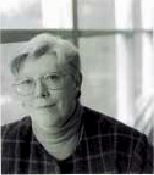.gif)
by Kathryn Brooks
In the early 1970s, as the women’s movement gained
momentum in the U.S., college campuses were being challenged to meet the
growing needs of women students, staff, and faculty. Women’s centers
were being established throughout the nation with two agendas: providing
services for a large number of women who had not completed a college education
in the ’50s and ’60s, a phenomenon noted by Betty Friedan in
her 1963 book, The Feminine Mystique; and creating equity on campus for
women faculty, staff, and students, a major issue that resulted in the
Title IX legislation of 1972. Fueled by their own experiences, a visionary
group of campus and community women advocated for such services at the
University of Utah. Their efforts resulted in the establishment of the
Women’s Resource Center (WRC) in July 1971. Looking back at the climate
in which they were working, I am astounded at their foresight and tenacity.

Kathryn Brooks
Director of the
Women’s Resource
Center at the U of U
No blueprints existed on how to establish a center; however, with support
from the University’s only woman administrator, Virginia Frobes BA’34
MA’35 PhD’58, vice president for student affairs, the idea became
a physical reality. In its first year, the center was housed in the Annex
and furnished with donated or “recycled” furniture and equipment.
Just one year later, it was relocated to a more visible area—the
“Browsing Room” in the Olpin Student Union. The staff used the
space in the front part of the lounge, removing and locking up their equipment
across the hall at night. Gradually the center “took over” the
entire room—including the flagstone fireplace—adding desks,
moveable walls, more donated furniture, and a library with books by and
about women, which continues to be a valued resource.
The WRC became the University’s focal point for large numbers of
returning women students. The staff developed programs and provided support
to assist them in overcoming the barriers that existed in a setting designed
for 18-22 year olds. They established the first nontraditional scholarships,
began a program to overcome math anxiety, and developed an academic support
course entitled “Three to Get Ready.”
The center also became renowned for its annual conferences that focused
on important women’s issues addressed by prominent speakers of that
era, including a fabled evening with Gloria Steinem. Working with other
women in the community, WRC staff established services for rape survivors
and victims of domestic violence. And it played a role statewide in helping
to found the Consortium for Utah Women in Higher Education and HERS/West,
a professional development and networking organization in the Rocky Mountain
West. In the 1970s the center began a feminist therapy counseling program,
which evolved into a nationally recognized Feminist Therapy/Multicultural
Practicum for students of both social work and clinical psychology. Graduates
of the program are now practicing in the national and international arena.
During the ’70s and ’80s WRC staff produced or
coordinated major reports on the status of women on campus and was one
of the first to use Bernice Sandler and her monograph The Campus Climate:
A Chilly One for Women as an educational resource. The center pushed for
the development of policies and procedures on sexual harassment (a term
coined in the late 1970s) to protect women on campus. The staff advocated
for hiring and promoting more women, began a program for single parents,
and advocated for campus child care. In the early 1990s, the center brought
the issue of date/acquaintance rape to campus through its peer education
programs and, with its “Seeds of Violence” program, continues
to work toward eliminating violence to women on campus and in the community.
Today, we have committed ourselves to increasing opportunities for women
of color on campus and joined the efforts to encourage diversity at the
University of Utah.
For 30 years the center has been the change agent for Utah women. Thirty
years ago the founding mothers believed equity would have been achieved
by 2000. Although many of the barriers they set out to remove have fallen,
and we hear from thousands of women who have achieved personal goals with
the center’s help, we have not yet attained women’s full participation
in all areas of University life. Recently, in an address at Rutgers University’s
Institute for Women’s Leadership, Patricia Harwood observed, “Even
as we look to the 21st century, women are still the exception instead
of the rule in visible leadership roles. Our society critically needs
the benefits that accrue by having both genders represented in its key
leadership roles.”
Today, a strong, nationally recognized WRC continues its tradition of
training and advocating for women’s leadership in the University—and
the world—of the 21st century.
Top of this Page - Questions, Comments - Table of Contents
Copyright 2001 by The University of Utah Alumni Association
.gif)